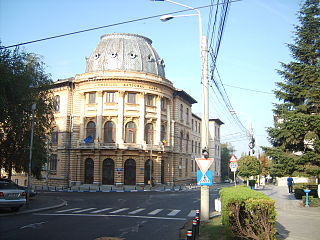Contents
| |||||
| Decades: | |||||
|---|---|---|---|---|---|
| See also: | |||||
Events from the year 1941 in Romania.
| |||||
| Decades: | |||||
|---|---|---|---|---|---|
| See also: | |||||
Events from the year 1941 in Romania.

The University of Bucharest (UB) is a public research university in Bucharest, Romania. It was founded in its current form on 4 July 1864 by a decree of Prince Alexandru Ioan Cuza to convert the former Princely Academy into the current University of Bucharest, making it one of the oldest Romanian universities. It is one of the five members of the Universitaria Consortium.

Șerban Vodă Cemetery is the largest and most famous cemetery in Bucharest, Romania.

The House of Cantacuzino is a Romanian aristocratic family of Greek origin. The family gave a number of princes to Wallachia and Moldavia, and it claimed descent from a branch of the Byzantine Kantakouzenos family, specifically from Byzantine Emperor John VI Kantakouzenos. After the Russo-Ottoman War of 1710–11, a lateral branch of the family settled in Russia, receiving the princely status. In 1944, Prince Ștefan Cantacuzino settled in Sweden, where his descendants form part of the unintroduced nobility of that country.

The Saint Sava National College, Bucharest, named after Sabbas the Sanctified, is the oldest and one of the most prestigious high schools in Romania. It was founded in 1694, under the name of the Royal Academy of Bucharest.

The Carol I National College is a high school located in central Craiova, Romania, on Ioan Maiorescu Street. It is one of the most prestigious secondary education institutions in Romania. Between 1947 and 1997 it operated under the name of Nicolae Bălcescu High School.

Nicolae Ciupercă was a Romanian general, born in Râmnicu Sărat. He served during World War I and World War II under the command of Alexandru Averescu and then Ion Antonescu, but would retire from a military life in 1941 over strategy disagreements with Antonescu. He also served as Minister of National Defense in 1938–1939.

Vasile Vasilievici Stroescu, also known as Vasile de Stroesco, Basile Stroesco, or Vasile Stroiescu, was a Bessarabian and Romanian politician, landowner, and philanthropist. One of the proponents and sponsors of Romanian nationalism in Russia's Bessarabia Governorate, as well as among the Romanian communities of Austria-Hungary, he was also a champion of self-help and of cooperative farming. He inherited or purchased large estates, progressively dividing them among local peasants, while setting up local schools and churches for their use. An erudite and traveler, he abandoned his career in law to focus on his agricultural projects and cultural activism. For the latter work, he became an honorary member of the Romanian Academy.

Gherman Vasile Pântea was a Bessarabian-born soldier, civil servant and political figure, active in the Russian Empire and Romania. As an officer of the Imperial Russian Army during most of World War I, he helped organize the committees of Bessarabian soldiers, oscillating between loyalty to the Russian Provisional Government and the cause of Bessarabian emancipation. Pântea was subsequently Military Director of the Moldavian Democratic Republic, answering to President Ion Inculeț. He personally created a Bessarabian defense force, tasked with combating Bolshevik subversion and Russian intimidation, but also braced for defeat after the October Revolution.

Chișinău has a recorded history that goes back to 1436. Since then, it has grown to become a significant political and cultural capital of South East Europe. In 1918 Chișinău became the capital of an independent state, the Moldavian Democratic Republic, and has been the capital of Moldova since 1991.

Nichita Smochină was an ethnic Romanian activist, scholar, and political figure from what is now Transnistria. He is especially noted for campaigning on behalf of Romanians in the Soviet Union. He was first active in the Russian Empire, serving with distinction in World War I. He turned to Romanian nationalism in 1917 when he was serving as an officer in Russian Transcaucasia. Smochină met Bolshevik leader Vladimir Lenin, recording Lenin's then-tolerant views on Romanian emancipation. Smochină was then active in the Ukrainian People's Republic, where he led the general caucus formed by Romanians in Tiraspol. He was also part of the Central Council, and earned his reputation as a champion of Transnistrian Romanian interests.

Eternitaté is the biggest cemetery in Iași, Romania.
Events from the year 1940 in Romania.
The following lists events in the year 2016 in Romania.

Jilava Prison is a prison located in Jilava, a village south of Bucharest, Romania.